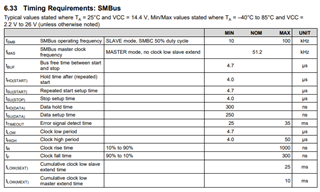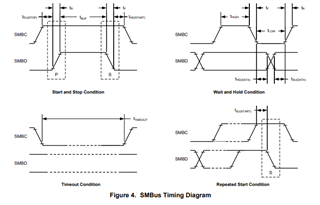Other Parts Discussed in Thread: EV2400
Tool/software:
Hello experts,
Currently my customer is using our EVM to test BQ4050 for their robot vacuum pjt.
Below is a waveform of SMBus communication (CH1 : CLK, CH2 : DATA) and they have connected the BQ4050EVM directly to their vacuum robot set, to do communication with their main board MCU, instead of their PC using EV2400.
With the CLK waveform, the HIGH voltage level is around 1.3V, with duration of around 5.33us. LOW is around 0.18V.
- Could you please check if the SMBus waveform is ok, in terms of Data & Clock lines' HIGH & LOW voltage level, duration, etc., and share your feedback with me?
- They found spike-like waveforms, as marked in blue below, repeatedly. Would this be the Data line failing to go HIGH? Is this something that may happen frequently?
- For the spike-like waveforms, may I ask what could be the potential cause of this?

Thank you in advance for your help and support.
Best regards,
Jade




